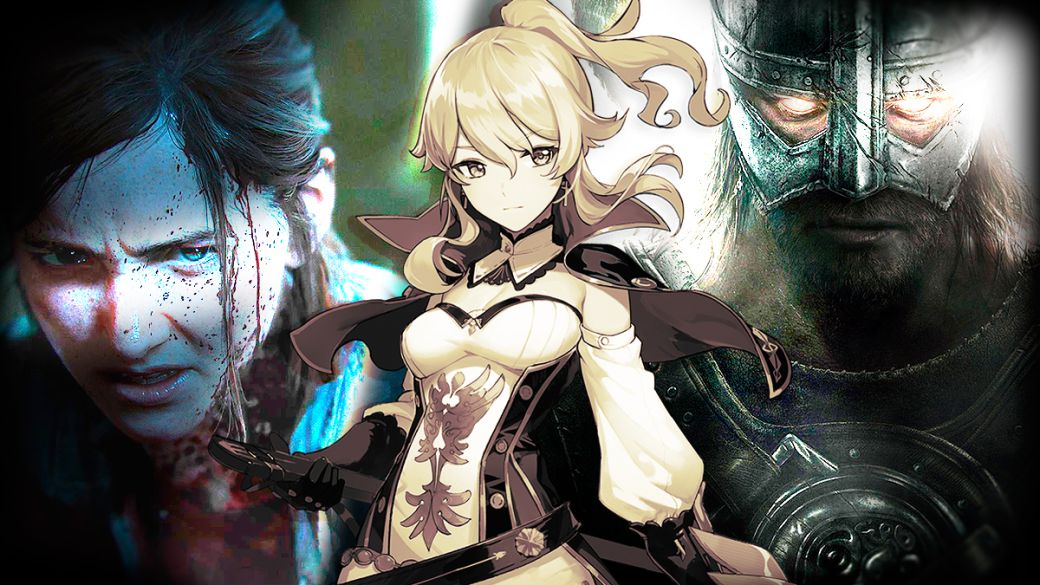
We investigated the role of the player within works such as Skyrim, The Last of Us Part II, Genshin Impact and many more according to various film studios.
We open our eyes to see a wobbly wooden surface. When we raise our heads we realize that we are sitting in a car. “Hey you, you’ve finally woken up,” Rolof tells us. We don’t know what we’re doing there, why do we know that Rolof is called that, or who we are. The legendary Dovahkiin, perhaps? Or a thieving Khajiit who has fallen into the clutches of the law? This matters much less to us when a dragon appears that destroys everything in its path and makes us put our feet in dust until we reach the character design menu.
(Notice: There are minor spoilers for The Last of Us Part II and Danganronpa V3 in this article)
In The Elder Scrolls V we have total freedom to choose from which perspective we want to enter the lands of Skyrim. We have the answer to all the above questions, and most of them will not have more weight than what we want to give when it comes to role-playing, because most likely we will use the camera in the first person practically all the time . We are any inhabitant of the region, we can even be an adaptation to this world of our own person, if we act according to our ideology and we configure ourselves as a human at the time of starting the game.
This is the case with The Elder Scrolls and many other role-playing games that invite us to an open world where we can act in the way that we see fit, thus giving rise to role-playing and endless possibilities. But what about other genres? Or even within RPGs, who are we in The Witcher 3? A tormented Gerald of Rivia, whose past we do not know or how he got to the situation he is in? To try to answer some of these questions (or at least reflect on them, since there is no single point of view from which to analyze the matter) we are going to base ourselves on psychoanalytic studies that have analyzed the role of the viewer in the cinema, and transfer it to the field of video games.
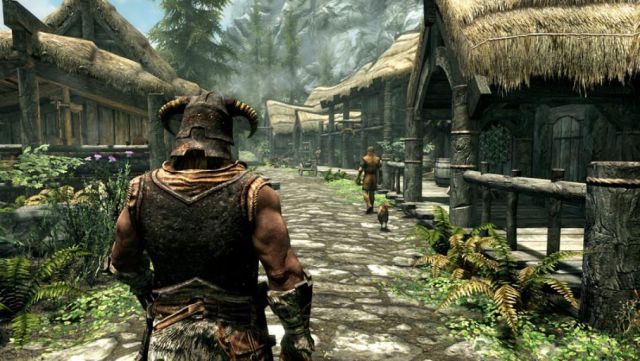
The mirror phase: the screen as a reflection of the player
Freud and Lacan developed the mirror phase theory on which other scholars later relied to interpret moviegoers. Broadly speaking, the theory says that a hypothetical six-month-old baby becomes aware of his own corporeity by looking at himself in the mirror in his mother’s arms: if his mother is reflected on that surface, therefore, the thing he is holding in his arms is the same.
Many authors agree that the cinema screen acts as this mirror, but a dilemma arises when it does not find its own reflection in it, but rather a story and a series of characters other than itself. In the field of video games a similar mechanism occurs: we take control, we make that nice little plumber squash that mushroom with eyes but we (at least in most cases) are not a plumber with a jumping ability shocking nor do we live in a world populated by Goombas, sadly. So who are we? Perhaps in this case a higher entity with the responsibility of calculating the protagonist’s jumps to the millimeter, using the information we obtain from seeing the situation and the enemies in advance thanks to the positioning of the camera. But this we will analyze in depth later.

Projection
Jacques Aumont identifies two simultaneous ways in this process: identification and projection. The case of projection has a much more significant weight in video games than in cinema because, after all, we are participating in history in one way or another with our own inputs. In titles like Detroid Become Human, our input, our decisions, are a decisive factor for the development that history takes and the port it reaches.
On the contrary, in The Last of Us Part II our interaction is necessary, but we do not have the option of taking a different path than the bloody revenge route that Ellie has chosen. We have to tighten the circle when the moment calls for it, and if we don’t, the scene just doesn’t move forward. In that case, our opinion and ideology do not matter, because the protagonist is Ellie and not the player. And, when the point comes where we consider releasing the controls and turning off the console because we feel that Ellie is getting the issue out of hand, we move on to control Abby, another character who has made at least questionable decisions and who , at first, we do not want to carry.

In the case of Naughty Dog’s most recent work, as players we do nothing more than play a story in which we are forced to get involved by executing the actions that the characters want to do that make us control. This occurs to the point where the title speaks practically directly to the viewer to ask “Hey, the anger and thirst for revenge that you felt in the first bars of the game, where has it taken you? Are you happy and proud of how Ellie ended up because of you? We do not have options or different routes to take, but the feelings that certain scenes generate in the player, ends up looking like a sermon about everything we have done wrong.
We are not Ellie, we are not Abby and we are not an omnipotent being at the controls because we lack information at all times and we cannot force the characters to do what we, individually, think is most appropriate. In The Last of Us Part II the player is treated as such, a person at the controls who is forced to rethink his role as a player in all the titles in which we have massacred groups and groups of nameless NPCs and without regard. This type of message has been seen before and applied in various ways in titles like Shadow of the Colossus, for example.
However, the projection mechanisms are mostly used less aggressively. In Life is Strange, Max is a relatively void of personality who relies on our intervention to be active when interacting with his environment. Our beloved Link, from The Legend of Zelda, does not speak and, in this way, it is much easier for the player to take the character as his own avatar within the game. In Man Of Medan, the buttons that we press will not change the irritating personality of the characters, but they will be defining when it comes to saving themselves or not from a terribly bloody death.

The primary identification: the player is the camera
We’ve already talked about how projection can be a double-edged sword. On the other hand, the issue of identification can be somewhat more convoluted. In the cinematographic field, scholars distinguish two different classes: primary and secondary.
The first of these is the case that we have already touched on tangentially in previous paragraphs: identification with the camera. Let’s take a simple case: in a third-person shooter, we have much more information than the character we control. We have a greater field of vision, often from a somewhat steep angle that allows us to detect the heads of enemies crouching in the distance and, even when we cover ourselves, we can continue to see the entire combat field even though our character is looking. to the ground or to a single side. This case also applies to titles of the MOBA genre, such as League of Legends, where the characters you pilot are little more than tools with specific abilities to defeat the rival team.
Another primary identification case is that of games like Genshin Impact. It’s no longer just about the positioning of the camera, but the concept of the game itself. In social networks the title has been called “the waifus game”. This term leads us to think that the characters (both male and female in the title, despite the fact that the name refers only to female characters) are items to collect. Either to shape a “harem” of characters that belong to you because you have had the divine luck to be touched in a gachapon or to complete a page of a stamp collection, there is no identification with the characters by the player : they are tools of a superior being who wants to show off that he has Venti and Diluc in the quarry.

Something similar happened at the beginning when Lara Croft was treated as a figure pleasant to the eye who walked through snowy places in suspenders: the perspective of the game and the concept of player that was had at that time invited to reduce Croft to little more Than a pretty woman who shot a dinosaur to death. Of course, this was much more marked in the advertisements and the use made of the character outside the titles than in the games themselves, and this conception has been transcended so that Croft is a character who gave voice to many players who had not never seen a woman as the protagonist of an adventure title.
A genre that goes a bit further in the field of primary identification is that of virtual reality. VR invites us to almost total immersion in the titles, most of them taking advantage of the possibilities offered by a first-person point of view in those conditions. Resident Evil 7 in VR makes us feel the tension and fear of being devoured by any monster from beyond in a much more visceral way than you would with a controller or a mouse in your hand (as long as we manage to overcome previous dizziness and discomfort ). The superior being that we are in Tetris Effect who has to face the adversity of not being beaten at a critical moment is much more involved in the title with the help of virtual reality glasses. It is a field that still has much to squeeze, but the course that the developers of these titles have taken so far points to the involvement of the player as a protagonist in the first person, who is physically exposed to the dangers that may exist in the games.
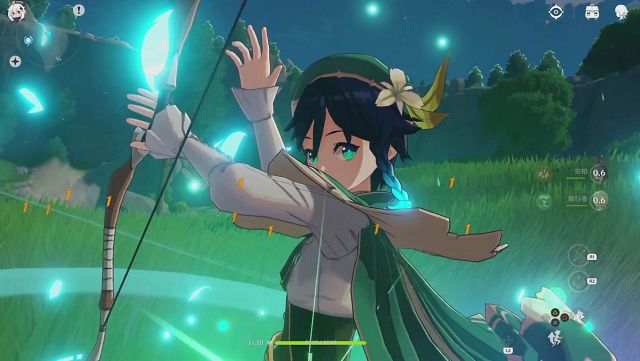
Secondary identification: society and protagonists
Finally, we have secondary identification, which in turn is divided into two subcategories: identification as part of a society and with a specific character. A clear example of the first class is The Walking Dead by Telltale Games. Luckily, we haven’t experienced a zombie apocalypse yet (although we’re pretty close). However, we do have as a collective concept the idea of a world full of dangers in which monsters are terrifying, but the real threat is humans themselves taken to extreme situations. This aspect of the apocalypses has been covered in numerous cultural productions, and Telltale’s title is not far behind. During the hours of adventure we can become more fond of some characters than others, we can shed tears for the loss of some and rejoice that others disappear from the map, but we do not embody any of them in their entirety.
They are characters with their own attributes given by the script and, although we may feel more represented by some than by others, there is no empty avatar that depends on our input to have an ideology or a pattern of action. The identification that is generated in this type of history is as a society: as a social collective, the world’s population could end up in that situation. How would we act individually? Would we let that suspicious individual who bangs on the door for help into our little community? They are plausible situations in a hypothetical field where social behaviors with which we are familiar are reproduced.
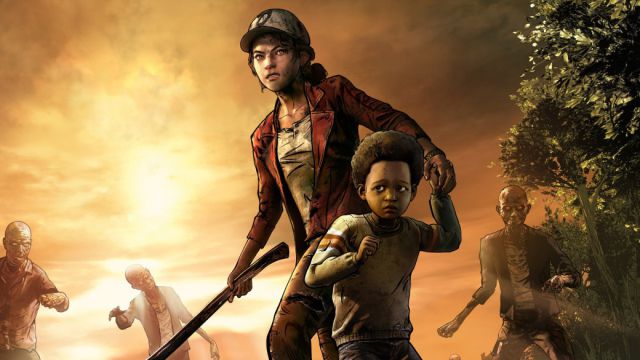
Regarding the identification with a character, we have already tangentially mentioned some of them: empty characters that depend on the way of thinking of the player to have one personality or another in the case of Life is Strange or the captain or captain Shepard in the Mass Effect saga, for example. We have also mentioned RPGs with an established narrative, as in The Witcher 3: we are not Gerald of Rivia, but we make decisions for him based on his previous personality. That is, we are a kind of conscience that whispers in your ear where to go and in what tone to respond to certain dialogues, but Gerald is Gerald and the players can’t do much to change it. In fact, most dialogue options influence the final outcome of the story, and not Gerald’s configuration as a character.
In titles such as the recent Watch Dogs Legion, we are a strategist who makes the most efficient decisions in pursuit of the revolution, not that endearing old woman with a taser who made us all fall in love a few months ago, and in Danganronpa V3 we end up being a fundamental element of the universe of the saga with a magnificent collapse of the fourth wall. In Persona 5 we believe to be an omnipotent entity and an optimal time manager for the Joker until they begin to omit information about fundamental events and meetings based on fades to black that they do not leave in ignorance.
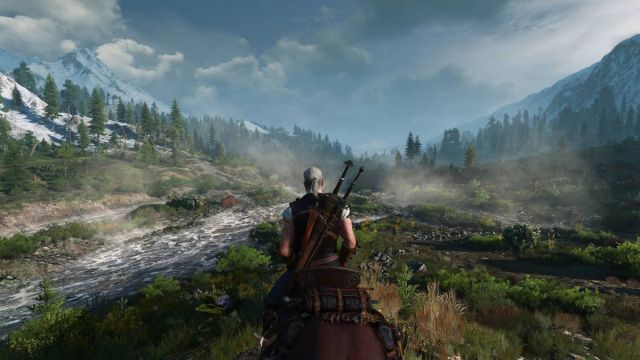
In summary, the key for a player to enjoy a title and to identify with it may go something beyond the gender, sexual orientation or gender identity of the protagonist in question. With Tyler from Tell Me Why not only trans people have to feel identified: in fact, it can be a good exercise for cis players, to understand some of the difficulties and experiences that a trans person goes through. Any player can enjoy the adventures of Nathan Drake and Lara Croft, regardless of gender, and whether Eivor from Assassin’s Creed Valhalla is male or female has zero relevance to their adventures.
Of course, the more variety of characters and personalities we find in the casts of the games, the better for everyone. As we have seen, identification with a game goes beyond the controllable character in question, and representation variety is more about giving a voice to groups that have not had it until now than with the player being able to see himself more or less identified with a protagonist. If it weren’t this way, no one without orange fur and questionable aesthetic decisions could enjoy Crash Bandicoot 4: It’s about time.

In short, it is not necessary for a character to represent us on a physical and ideological level to identify ourselves with the title in which he stars, or for us to be involved in the story. There is no one way or one correct way to approach a title, and the greater the range of points of view it offers, the richer the work. We have reviewed some of the identification mechanisms used today in video games, but no one knows how these can evolve with the features offered by the new generation of consoles. Over the years, the medium can surprise us in this regard in ways that we have not even conceived yet.

Sources:
Aumount, J., Bergala, A., Marie, M., Vernet, M. (1993). Cinema aesthetics. Filming space, editing, narration, language. Barcelona, Spain: Paidós.
The mutations of the spectator. Cinema as the aesthetics of the crowd – Carlos Fernando Alvarado Duque
